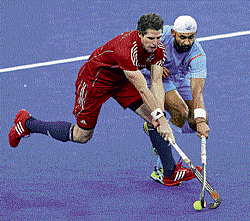Over the years the playing surface in hockey has undergone major changes and along with it has come praises and criticism in varying measures.

From gravel to grass to sand-based artificial turfs to water-based artificial turfs, hockey — unlike many other field sports — has constantly seen its performing stage change and the latest act that has ruffled the feathers of many is the blue and pink surface that will used during the London Olympics.
In a bizarre move, the sport’s world body, the FIH, allowed the organisers of the July 27-August 12 Games to lay a blue and pink pitch without even testing it out in a major event and their decision to change the colour of the turf and the ball (white to yellow) has not gone down very well with many coaches and players. The colour of the turf, and more importantly, its quality, has caused concern among the hockey elite, with its unpredictable bounce troubling the players.
“This is absolutely ridiculous,” fumed former India captain and two-time Olympian Jude Felix, echoing Australia coach Ric Charlesworth’s outburst during the ongoing four-nation test event at the River Bank Arena -- the hockey venue at the London Games. “Most sportspersons, including me, follow just one mantra — don’t fix it until it’s broken. Green has been the colour of choice for decades now and what is the need for changing it to blue, and just for one event?
“Football is played on green, cricket is played on green, and rugby is played on green. Many other sports too are played on green. The logic is very simple — grass is green and that is how nature is. It’s completely baffling how the FIH could think about bringing about such a massive change ahead of the Olympics.”
According to the FIH, the major reason for changing the colour of the pitch and the ball is to make the game more attractive and television friendly. Parallels can be drawn to the US Open tennis tournament that switched to blue hard courts in 2005, a move which was embraced by the Australian Open in 2008.
The last two IAAF World Championships in athletics -- Berlin (2009) and Daegu (2011) -- were held on blue tracks and the ongoing Madrid Open tennis tournament is being played on blue clay instead of the traditional red for the very first time.
In general, the reason given by many for the blue switch is that it enhances television contrast by 27 percent. In London, another factor also influenced the move, with blue and pink being the colour chosen for the Games’ theme. Appeasing the television audience is crucial for the growth of sport, but should it come at the cost of players’ interest is the question.
“One knows that change is an inevitable part of sport. But few things have remained constant, like the number of players, team wearing different jersey colours, goalkeeper in altogether different outfit from that of his team-mates. If the FIH decided to change the colour, they should have first experimented it in events like the Champions Trophy, Champions Challenge or Junior World Cup,” added Felix.
“They should have then sought the opinion of the players and coaches. Ultimately it’s them who are playing on it and not the members of the executive committee who make these stupid and ridiculous decisions. The amount of effort and preparation that goes into preparing for the Olympics is massive. For many it’s a lifetime dream. Tinkering with that just shows that the FIH is oblivious to the needs and demands of the players.”
The colour of the pitch is not the main factor causing worry. According to India coach Michael Nobbs, the brand new pitch is far more bouncy and makes it difficult for players to control the speed and direction. The same observation came from Charlesworth, who said the pitch does not reward skill and is yet to settle in, causing injuries to players. Charlesworth was upset after one of his defenders -- Graeme Begbie -- suffered a serious knee injury and was ruled out of the Olympics.
“FIH is making the same mistake what they did at the 1976 Montreal Olympics,” noted Vasudevan Baskaran, who led India to their last Olympic gold medal in 1980 at Moscow. “They introduced astro-turf at the ’76 Games but we played the 1978 and 1982 World Cup on natural grass. Imagine playing on two different pitches at such major events. India was such a dominant force, but they never brought us into confidence while making these decisions.
“Turf apart, there have been so many rule changes over the years, but has enough study been done on them? The problem with FIH is its organisation itself. Australia are the reigning world champions and the number one side, but they just have one member in the executive committee. India has none. You can’t have guys from Belgium or Venezuela voting on what is good or bad for hockey. This has to change if the game has to move forward,” added Baskaran.
Installing a brand new pitch is an expensive affair for many nations. Why would a country invest so much money on getting one laid if there is no guarantee that all future events would be played on it. Some of the participating teams at this summer’s Games do not even have the blue pitch and are travelling to places that possess them.
The organisers might have brushed aside the concerns of the team, saying that by the time the Games arrive, the turf would have settled down, with matches scheduled on it right till the Games. Still, going by the opinions from the players and coaches, the FIH could have exercised some caution before taking the plunge.
